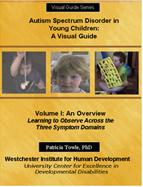Westchester Institute for Human Development UCEDD/LEND Produces New Autism Training DVD
July 2, 2009
![]() http://childdevelopmentmedia.com/assessment-planning/02001a.html
http://childdevelopmentmedia.com/assessment-planning/02001a.html

|
Autism spectrum disorder (ASD) is no longer seen as a rare condition, but one that can affect any family in any walk of life. Parents are usually the first to realize something is "different" about their child, but often have to wait for months, or even years, before a professional provides them with a diagnosis and guidance for all-important early intervention. For this reason, the more individuals who can contribute to early identification of young children with ASD, the better.
This DVD addresses this need by providing explicit instruction in how to observe key behaviors in young children to help make a judgment about possible autism. Extensive video illustrations are from home movies of children with autism spectrum disorder, with comparison to typically developing children filmed for this project.
For professionals-in-training across pediatric healthcare and child development professions, this training complements course instruction and clinical rotations. For established professionals, it enhances previous training. For those in a position to refer a child's family for evaluation, the DVD provides clear examples of "what to look for."
Volume 1 presents an overview of issues in detecting ASD in young children, and a review of the three symptom domains of Social Interaction, Communication, and Repetitive Behaviors. Subsequent volumes treat each of these three domains in greater detail. Table of Contents
Part 1: Introduction and Overview
Section 1. Overview of Visual Guide Series and Volume 1
Section 2. Overview of autism spectrum disorders in young children
Part 2: Social Interaction
Section 1: Overview; Social behavior elements: seeking proximity, eye contact, monitoring faces and eyes, sharing affect, signaling affect, imitation, turn-taking
Section 2. Social Functions: initiating, responding, maintaining
Part 3: Communication
Section 1. Overview; Communication modalities and their coordination: eye contact, gesture, and vocalization
Section 2. Intentional communication: request, comment, negate, protest, greet, answer, acknowledge
Section 3. Atypical communication: echolalia, scripting, atypical babbling, instrumental communication, unusual prosody
Section 4. Joint attention
Part 4. Restricted and Repetitive Behaviors
Section 1. Overview; Organization model
Section 2. Repetitive Behaviors: seeking and avoiding sensation, seeking visual stimulation, interest in cause-effect mechanism and parts of objects, seeking to maintain sameness, areas of high interest and ability
Conclusion
90 minute, DVD
Produced by:
Patricia Towle, Ph.D., Clinical Child Psychologist
Westchester Institute for Human Development
University Center for Excellence in Developmental Disabilities
Valhalla, NY







